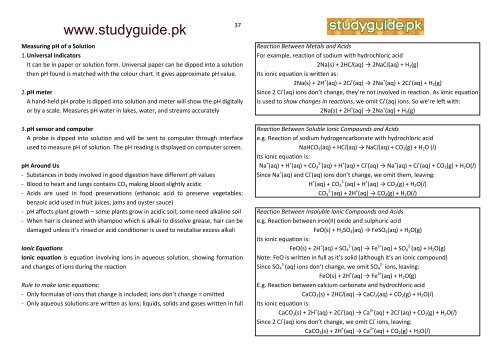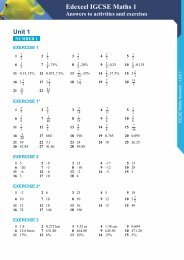O-Level-Chemistry-Notes
O-Level-Chemistry-Notes
O-Level-Chemistry-Notes
You also want an ePaper? Increase the reach of your titles
YUMPU automatically turns print PDFs into web optimized ePapers that Google loves.
www.studyguide.pk<br />
Copyrights AF/PS/2009/2010 37<br />
Measuring pH of a Solution<br />
1. Universal indicators<br />
It can be in paper or solution form. Universal paper can be dipped into a solution<br />
then pH found is matched with the colour chart. It gives approximate pH value.<br />
2. pH meter<br />
A hand-held pH probe is dipped into solution and meter will show the pH digitally<br />
or by a scale. Measures pH water in lakes, water, and streams accurately<br />
3. pH sensor and computer<br />
A probe is dipped into solution and will be sent to computer through interface<br />
used to measure pH of solution. The pH reading is displayed on computer screen.<br />
pH Around Us<br />
- Substances in body involved in good digestion have different pH values<br />
- Blood to heart and lungs contains CO2 making blood slightly acidic<br />
- Acids are used in food preservations (ethanoic acid to preserve vegetables;<br />
benzoic acid used in fruit juices, jams and oyster sauce)<br />
- pH affects plant growth – some plants grow in acidic soil; some need alkaline soil<br />
- When hair is cleaned with shampoo which is alkali to dissolve grease, hair can be<br />
damaged unless it’s rinsed or acid conditioner is used to neutalise excess alkali<br />
Ionic Equations<br />
Ionic equation is equation involving ions in aqueous solution, showing formation<br />
and changes of ions during the reaction<br />
Rule to make ionic equations:<br />
- Only formulae of ions that change is included; ions don’t change = omitted<br />
- Only aqueous solutions are written as ions; liquids, solids and gases written in full<br />
Reaction Between Metals and Acids<br />
For example, reaction of sodium with hydrochloric acid<br />
2Na(s) + 2HCl(aq) → 2NaCl(aq) + H2(g)<br />
Its ionic equation is written as:<br />
2Na(s) + 2H + (aq) + 2Cl - (aq) → 2Na + (aq) + 2Cl - (aq) + H2(g)<br />
Since 2 Cl - (aq) ions don’t change, they’re not involved in reaction. As ionic equation<br />
is used to show changes in reactions, we omit Cl - (aq) ions. So we’re left with:<br />
2Na(s) + 2H + (aq) → 2Na + (aq) + H2(g)<br />
Reaction Between Soluble Ionic Compounds and Acids<br />
e.g. Reaction of sodium hydrogencarbonate with hydrochloric acid<br />
NaHCO3(aq) + HCl(aq) → NaCl(aq) + CO2(g) + H2O (l)<br />
Its ionic equation is:<br />
Na + (aq) + H + (aq) + CO3 2- (aq) + H + (aq) + Cl - (aq) → Na + (aq) + Cl - (aq) + CO2(g) + H2O(l)<br />
Since Na + (aq) and Cl - (aq) ions don’t change, we omit them, leaving:<br />
H + (aq) + CO3 2- (aq) + H + (aq) → CO2(g) + H2O(l)<br />
CO3 2- (aq) + 2H + (aq) → CO2(g) + H2O(l)<br />
Reaction Between Insoluble Ionic Compounds and Acids<br />
e.g. Reaction between iron(II) oxide and sulphuric acid<br />
FeO(s) + H2SO4(aq) → FeSO4(aq) + H2O(g)<br />
Its ionic equation is:<br />
FeO(s) + 2H + (aq) + SO4 2- (aq) → Fe 2+ (aq) + SO4 2- (aq) + H2O(g)<br />
Note: FeO is written in full as it’s solid (although it’s an ionic compound)<br />
Since SO4 2- (aq) ions don’t change, we omit SO4 2- ions, leaving:<br />
FeO(s) + 2H + (aq) → Fe 2+ (aq) + H2O(g)<br />
E.g. Reaction between calcium carbonate and hydrochloric acid<br />
CaCO3(s) + 2HCl(aq) → CaCl2(aq) + CO2(g) + H2O(l)<br />
Its ionic equation is:<br />
CaCO3(s) + 2H + (aq) + 2Cl - (aq) → Ca 2+ (aq) + 2Cl - (aq) + CO2(g) + H2O(l)<br />
Since 2 Cl - (aq) ions don’t change, we omit Cl - ions, leaving:<br />
CaCO3(s) + 2H + (aq) → Ca 2+ (aq) + CO2(g) + H2O(l)



